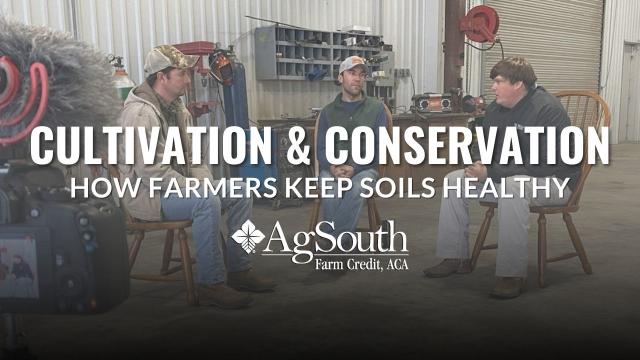Cultivation & Conservation: Keeping Soils Healthy

Southeast Georgia farmers David Cromley, JD Newton, and Ryne Brannen each farm cotton and peanuts with their families. All in their 30’s, these young farmers are driven to grow the highest quality crops they can, in an environmentally conscious way, that is also sustainable for their farm business to pass down to another generation of farmers. Hear their conversation about how important it is they keep their soil healthy for their farms.
The Real Conversation: How Do Farmers Keep Soils Healthy?
With “conservation” and “sustainability” such a hot topic of discussion, who better to ask than the farmers themselves what they are doing to take care of our natural resources?
Farmers operate every day with the motto shared by farmer JD Newton, “If we take care of the land, the land will take care of us.” Farming IS sustainable because it’s still here! And farmers – as stewards of the land – are the ultimate conservationists. Farmers are already part of the solution to A. making sure the environment is taken care of, and B. feeding our growing world.
Southeast Georgia farmers David Cromley, JD Newton, and Ryne Brannen each farm cotton and peanuts with their families. All in their 30’s, these young farmers are driven to grow the highest quality crops they can, in an environmentally conscious way, that is also sustainable for their farm business to pass down to another generation of farmers.
Protecting the soil is one of the most important things farmers believe in – not only for the environment, but also to grow the best crops possible. Included in soil care is careful selection of crops for wise fertilizer application and crop rotation.
Not all soils and crops are created equal
Have you ever tried to grow tomatoes and not fertilize them? They turn yellow, throw off blooms, and fail to make a single tomato. Or planted them in some soil that just did not work well for growing a garden?
Soil type and fertilizer is critical for growing any kind of crop. It gives the plants the nutrients (nitrogen, phosphorus, potassium, and more) needed in order to produce fruit, vegetables, grains, etc. However, not all crops and fertilizers are created equal.
In the Southeast, sandier soils mean that fertilizers don’t stick around as long for the roots to absorb. (Think about how fast ocean water drains out of the sandy shore!) In the Midwest, soil is rich and deep so water and fertilizer stays in the ground longer. Corn needs a lot of water and fertilizer, so the Midwest soils are perfect for growing corn.
While corn can be grown in the South with the right soil and irrigation, many fields are not suitable to growing corn – so many farmers choose to grow cotton and peanuts. These crops grow well in dry, sandier soils (they are drought tolerant crops) and are more efficient at using fertilizer, so farmers can put out less.
That decision by itself means that farmers are growing what is sustainable and good for their land!
And fertilizer is not free – so the more that is needed, the higher cost to the farmer. These farmers must take care of the soil and choose not to put out any more fertilizer than what is absolutely needed – or they will be unable to stay in business.
“Economics regulates you. It makes you do what is the right thing. Because if you don’t take care of your land and let it get all washed out the field will not make any more (yield) and you’ll go broke,” says Ryne Brannen.
Crop Rotation is a win-win
While cotton needs far less Nitrogen fertilizer in the Southeast than corn, peanuts – they don’t need any Nitrogen fertilizer at all!
Peanuts are a legume – which means their roots have bacteria can actually make their own Nitrogen! Peas and beans are legumes too. Because of their ability to make Nitrogen, peanuts are important for Crop Rotation.
Crop Rotation is a farming practice where farmers rotate the crops they plant in a field each year. In the Southeast, cotton and peanuts are typically planted on a rotation: 1 year peanuts – 2 or 3 years cotton – 1 year peanuts – 2 or 3 years cotton. Why? There are a couple of reasons:
- Fertilizer efficiency. Since peanuts are a legume and can make their own Nitrogen, they can reach down deep in the soil and use some of the fertilizer and soil nutrients that cotton cannot get to. There is also little need for applying additional fertilizer to peanuts.
- Reduce Nitrogen fertilizer on cotton. Peanuts make Nitrogen for themselves, but they also leave some behind! Since peanuts can build up the natural Nitrogen in the soil, farmers do not need to put out as much Nitrogen on the cotton.
- Reduced disease. Peanuts are very prone to root diseases – which is not good for a plant that grows its crop underground! Planting cotton in between peanut crops reduces the pressure of disease of the peanuts, so fungicides are reduced and yields are improved.
Crop Rotation is certainly a powerful tool that many farmers use that not only improves yield, it can reduce costs AND is good for the environment!
As David says, “Knowledge is power.” The science involved in growing crops is incredible! The ability for farmers to know so much about how their crops grow lets them grow more food, on less land, and in a way that is good for the environment.
Sounds like we all win.